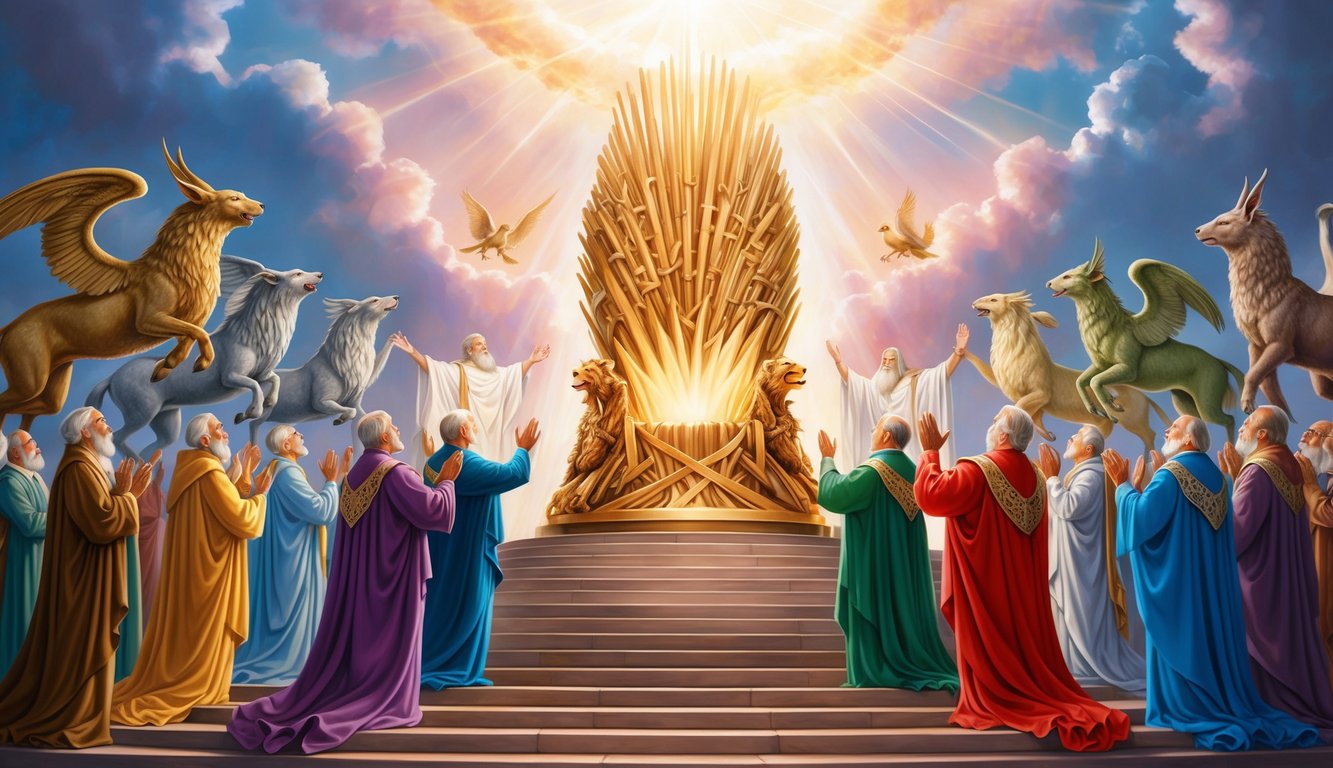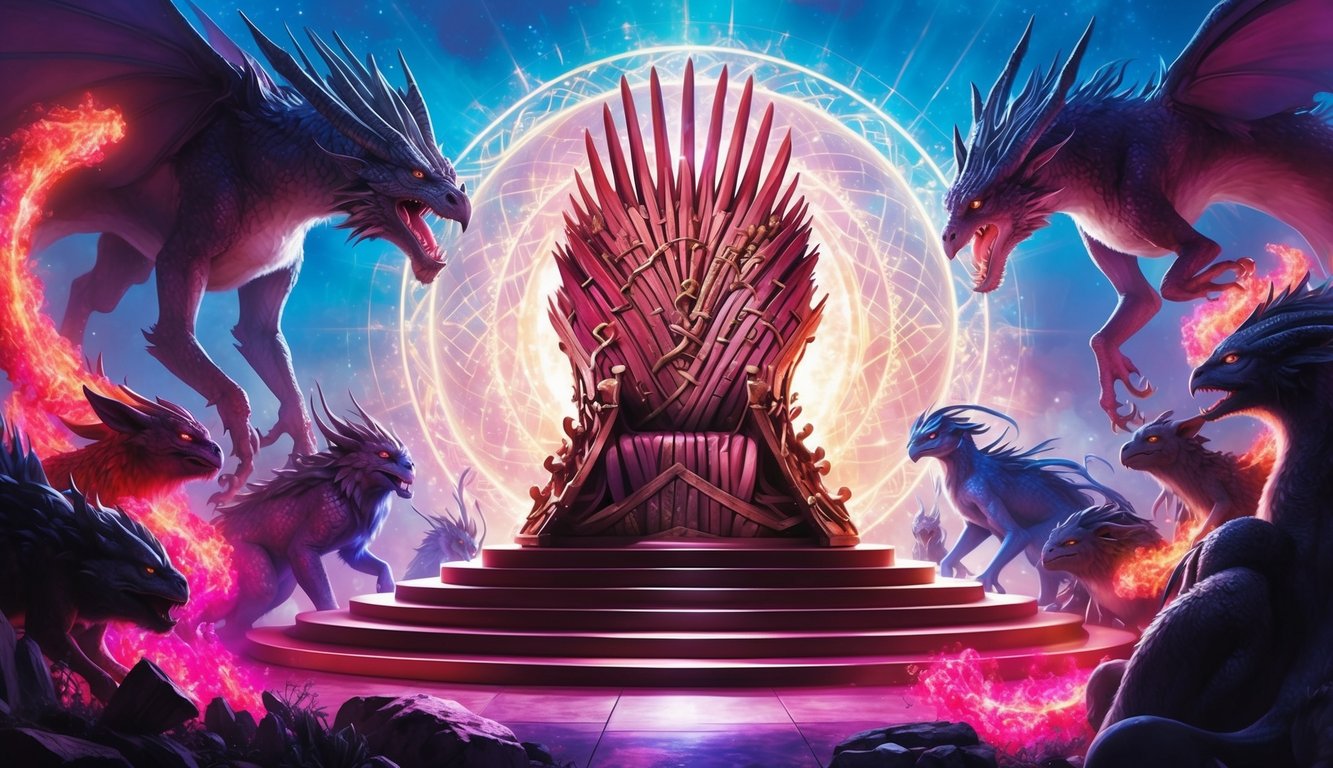Don’t Miss Out On This Unique Astrological Opportunity
Are you tired of spinning your wheels and getting nowhere? Simply put, you’re out of sync: you’re out of alignment with your astral configuration.
But: there’s a kind of map that can help you reclaim your alignment. Think of it as your own personal blueprint to success and happiness: a blueprint that will help you live your most amazing life.
Get started here.
Have you ever wondered what happens beyond the physical world? Revelation 4 offers a glimpse into a heavenly realm that promises to captivate your imagination.
In this chapter, the Apostle John describes a vision he had of a door standing open in heaven, revealing a magnificent throne surrounded by incredible scenes and beings. This vision invites you to explore a spiritual landscape filled with awe and wonder.
The setting of this vision is both mysterious and grand.
As you read through Revelation 4, you will encounter vivid images of heavenly participants in worship, each contributing to the divine atmosphere.
The descriptions are filled with symbolism, pointing to deeper spiritual truths awaiting your discovery.
In addition to the vivid imagery, Revelation 4 highlights the expressions of worship that occur in heaven.
The focus on worship and the presence of divine beings offer a sense of awe.
This chapter encourages you to ponder the significance of these heavenly expressions and their relation to your own understanding of spiritual worship.
The Heavenly Vision Described
In Revelation 4, a vivid depiction of a divine scene unfolds.
The focus is on the magnificent throne, its divine surroundings, and the awe-inspiring presence of God.
The Throne and Its Surroundings
When you first encounter the heavenly throne, it is set in a breathtaking scene.
The throne itself appears majestic, crafted from radiant materials.
Jasper and carnelian adorn it, colors merging in a glorious display.
A rainbow, appearing like an emerald, encircles the throne, casting a serene glow over the scene.
Around the throne, you can visualize the wonder of a sea of glass, clear and smooth like crystal.
The impression is one of purity and peace.
Lightning and thunder announce the presence and power surrounding the throne.
Displaying authority, the setting emphasizes the throne’s significance and grandeur.
The vision invites you to appreciate the divine essence and might captured in this vivid imagery.
The Presence of God
The vision becomes even more profound when focusing on the presence of God.
He sits upon the throne, enveloped in holiness.
The throne room radiates with His magnificence, reinforcing His sovereignty.
In this divine space, you also find the seven spirits of God.
These spirits symbolize perfect wisdom and presence, further emphasizing the completeness of God’s authority.
They stand before the throne, highlighting His omnipresence.
The spiritual ambiance is electric yet serene, emphasized by the elements like the lightning and the sea of glass.
This setting compels you to acknowledge God’s supreme dominion and the extraordinary atmosphere of heaven.
It is a vision that stirs both reverence and awe.
The radiant glow and the chorus of celestial beings further enhance the overwhelming sense of divine majesty.
In this sacred space, one is reminded of the profound blessings bestowed upon believers, including the list of spiritual gifts that equip them for their divine purpose.
This atmosphere encourages deep reflection and a renewed commitment to faith.
The Participants in Worship

In Revelation 4, worship is depicted with vivid imagery.
The main participants include the twenty-four elders and the four living creatures, each playing a unique role.
Understanding their presence helps grasp the scene’s significance.
Twenty-Four Elders
You encounter the twenty-four elders, each seated around the throne.
They are dressed in white garments and wear crowns of gold.
These elders represent leadership and wisdom, often seen as a reflection of the faithful community throughout history.
Their role in worship includes offering their crowns before the throne, symbolizing humility and submission to divine authority.
They sing hymns acknowledging God’s eternal nature and mighty works, emphasizing the reverence and honor due to the Lord God Almighty.
Four Living Creatures
The four living creatures are central to the worship scene, each with a distinct appearance: a lion, a calf, a face like a man, and a flying eagle.
These creatures have six wings and are full of eyes.
They are consistently engaged in worship, proclaiming, “Holy, holy, holy, Lord God Almighty.” This chant underscores God’s holiness and eternal power.
The living creatures represent creation’s entire spectrum, showing that every aspect of existence acknowledges God’s supremacy.
Their perpetual praise highlights their role as key participants in the heavenly worship described in Revelation 4.
Expressions of Worship in Heaven
In Revelation 4, worship is a vivid expression of holiness and divine power.
This chapter details the ways beings in heaven express reverence and awe towards God.
They focus on His eternal sovereignty and the majesty of His creation, regularly proclaiming His unmatched glory.
Proclamations of Holiness and Glory
At the heart of worship in heaven is the proclamation of God’s holiness and glory.
The beings surrounding God’s throne, such as the four living creatures, continually say, “Holy, holy, holy, Lord God Almighty.” Their worship emphasizes God’s perfection and His almighty power.
These proclamations reflect a deep acknowledgment of His majesty.
Their voices echo throughout heaven, reinforcing the belief that God alone is worthy of such praise.
This ongoing declaration illustrates the heavenly being’s devotion and their understanding of God’s supreme position above all creation, highlighting their gratitude and respect.
Declaration of God’s Eternal Sovereignty
Expressions of worship in heaven also focus on God’s eternal sovereignty.
The twenty-four elders offer thanks and honor, declaring that God, who has created all things, is worthy to receive glory and power.
Their declarations illustrate a heartfelt recognition that God’s rule is forever and ever.
As they lay their crowns before the throne, they express submission to His divine authority, symbolizing that all their power originates from God’s eternal reign.
These actions and words focus on acknowledging God’s ultimate control over the universe and affirming His timeless majesty and authority.
Frequently Asked Questions

Revelation Chapter 4 offers vivid imagery and symbols.
Understanding the roles of the 24 elders, the throne of God, the seven spirits, and the four living creatures is key.
This chapter also opens the path to exploring the events that unfold in the Book of Revelation.
What is the significance of the 24 elders in Revelation Chapter 4?
The 24 elders are often seen as representing the totality of God’s people.
Some interpretations suggest they symbolize the 12 tribes of Israel and the 12 apostles, uniting the Old and New Testaments.
Their presence highlights the continuity and fulfillment of God’s promises.
How is the throne of God described in the vision of Revelation 4?
In Revelation 4, God’s throne is depicted with vivid detail.
It is surrounded by a rainbow that resembles an emerald, signifying God’s sovereignty and grace.
The throne’s majestic and awe-inspiring description emphasizes God’s supreme power and authority over the universe.
What do the seven spirits before the throne symbolize in the context of Revelation 4?
The seven spirits are often interpreted as symbols of the Holy Spirit in its fullness.
They may represent divine perfection and completeness.
This imagery connects to biblical themes found in the Book of Isaiah, where the Spirit is described with seven attributes.
How are the four living creatures around the throne interpreted in biblical theology?
The four living creatures embody aspects of God’s creation.
Each creature—lion, calf, man, and eagle—represents different qualities like strength, service, intelligence, and swiftness.
They continuously praise God, highlighting the worship and adoration that God receives from all creation.
What lessons can be derived from the worship scenes portrayed in Revelation Chapter 4?
The scenes of worship emphasize total devotion and reverence for God.
The elders and living creatures model complete humility and praise.
These images encourage readers to consider their own relationship with God and inspire a spirit of worship and honor in their daily lives.
In what ways does Revelation Chapter 4 set the stage for the events that follow in the Book of Revelation?
Revelation Chapter 4 serves as a prelude to the dramatic events that follow.
It describes the heavenly throne room and worship.
This establishes the divine authority behind the judgments and visions of the chapters to come.
It reminds you that God’s plan is both sovereign and purposeful.



